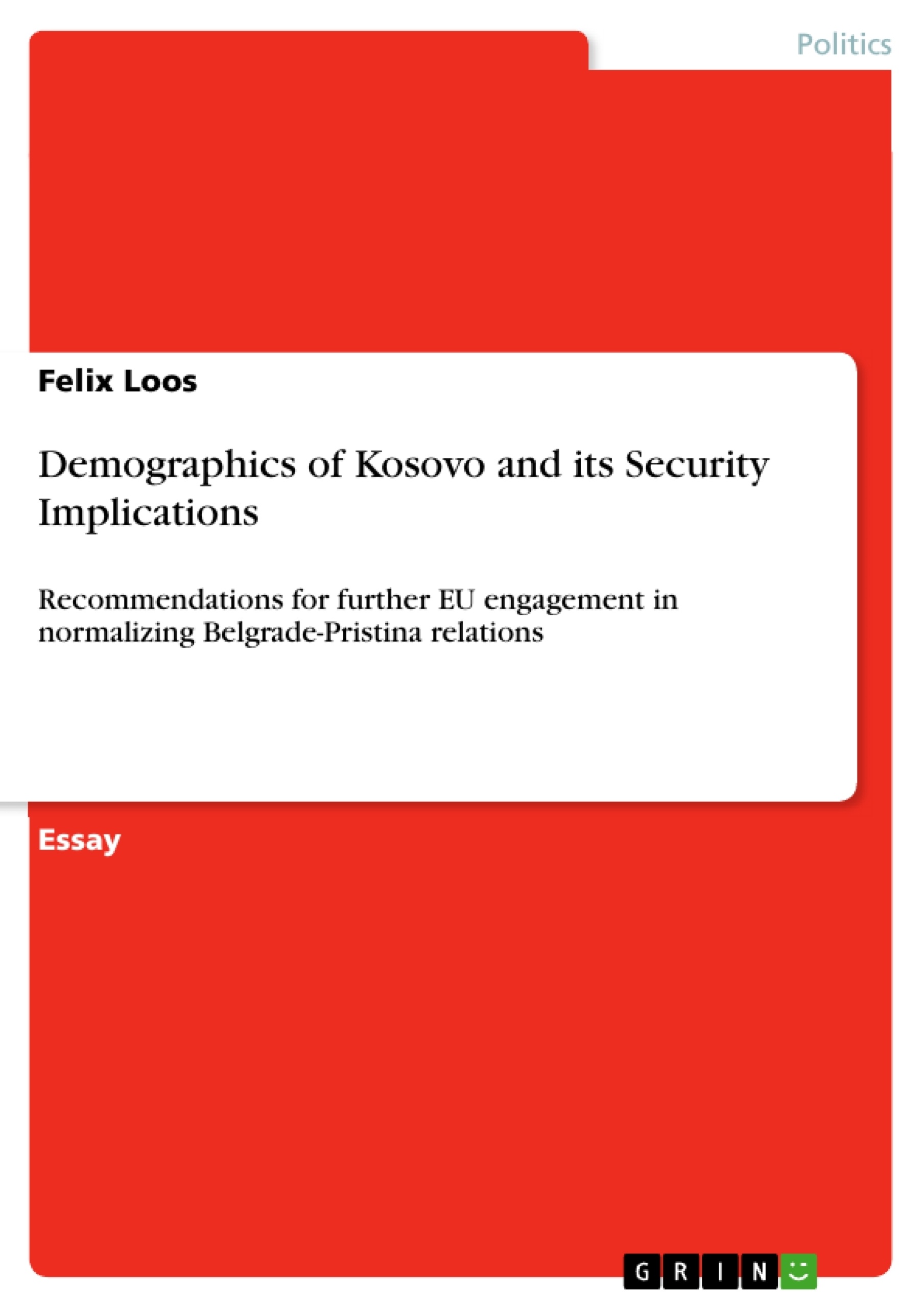This Policy Paper seeks to examine Belgrade - Pristina relations and the EU engagement to normalize them. It analyzes three measures the EU has taken, examines their impact and gives policy recommendations how further EU involvment regarding this topic should look like.
Inhaltsverzeichnis (Table of Contents)
- Growing tensions in Kosovo-Serbia relations
- Diagnosis: Demographics as a Security Risk
- Social Dimension: Violent clashes
- Institutional Dimension: Weak institutions and lack of acceptance
- Diplomatic Dimension: Disturbed political relations and mutual mistrust
- Countermeasures
- Social Dimension: Revitalization of Mitrovica Bridge
- Institutional Dimension: EULEX mission
- Diplomatic Dimension: EU-facilitated Belgrade-Pristina Dialogue
- Policy recommendations
- Social Dimension: "Bringing people together"
- Institutional Dimension: Extend EULEX mission (new focus)
- Diplomatic Dimension: Conditionalization of further financial support
Zielsetzung und Themenschwerpunkte (Objectives and Key Themes)
This paper analyzes the demographic situation in Kosovo and its implications for the security of the region and the relationship between Serbia and Kosovo. The aim is to develop policy recommendations for increased EU engagement in normalizing Belgrade-Pristina relations. This requires an understanding of the existing tensions and implemented countermeasures.
- The impact of Kosovo's ethnically divided population on regional security.
- The role of weak institutions and lack of acceptance of Kosovan authorities by Kosovo-Serbs.
- The importance of the EU's role in facilitating dialogue and normalization.
- The potential for violent clashes stemming from ethnic divisions.
- The need for revised EU strategies to improve the situation in Kosovo.
Zusammenfassung der Kapitel (Chapter Summaries)
Growing tensions in Kosovo-Serbia relations: This chapter establishes the context by highlighting the ongoing tensions between Serbia and Kosovo, using recent examples like the declaration of Serbia's prime minister as persona non grata in Kosovo and police raids in Serb-dominated villages. It emphasizes the fragility of the situation, referencing past violent confrontations and underscores the urgency for EU intervention given the countries' aspirations for EU accession and their importance for regional stability. The chapter sets the stage for analyzing the demographic factors contributing to these tensions and proposes policy recommendations for EU engagement.
Diagnosis: Demographics as a Security Risk: This chapter examines the demographic composition of Kosovo, focusing on the distribution of ethnic Serbs. It highlights the significant Serbian minority, particularly in northern Kosovo, and their largely separate governance from Pristina, symbolized by the divided city of Mitrovica and its iconic bridge. The chapter connects this demographic reality to the high risk of violent clashes, noting the lack of mutual understanding and possibilities for connection between Kosovo-Albanians and Kosovo-Serbs. The analysis lays the groundwork for exploring the security risks stemming from this situation, specifically in the social, institutional, and diplomatic dimensions.
Schlüsselwörter (Keywords)
Kosovo, Serbia, EU, Belgrade-Pristina relations, demographics, ethnic conflict, security risks, Mitrovica, EULEX, institutional weakness, violent clashes, inter-ethnic relations, EU accession, policy recommendations.
Kosovo-Serbia Relations: A Comprehensive Language Preview - FAQ
What is the main focus of this document?
This document analyzes the demographic situation in Kosovo and its implications for regional security and Kosovo-Serbia relations. It aims to provide policy recommendations for increased EU engagement in normalizing relations between Belgrade and Pristina.
What are the key themes explored?
The key themes include the impact of Kosovo's ethnically divided population on regional security; the role of weak institutions and lack of acceptance of Kosovan authorities by Kosovo-Serbs; the importance of the EU's role in facilitating dialogue and normalization; the potential for violent clashes stemming from ethnic divisions; and the need for revised EU strategies to improve the situation in Kosovo.
What specific aspects of Kosovo-Serbia relations are examined?
The document examines growing tensions, focusing on examples such as the declaration of Serbia's prime minister as persona non grata in Kosovo and police raids in Serb-dominated villages. It also analyzes the demographic composition of Kosovo, particularly the distribution of ethnic Serbs and their largely separate governance from Pristina.
How does the document address the demographic situation in Kosovo?
The document highlights the significant Serbian minority in northern Kosovo and their separate governance, symbolized by the divided city of Mitrovica. It connects this demographic reality to the high risk of violent clashes due to a lack of mutual understanding between Kosovo-Albanians and Kosovo-Serbs.
What are the identified security risks?
The security risks are analyzed across social, institutional, and diplomatic dimensions. Social risks include the potential for violent clashes. Institutional risks stem from weak institutions and a lack of acceptance of Kosovan authorities by Kosovo-Serbs. Diplomatic risks are linked to disturbed political relations and mutual mistrust.
What countermeasures are discussed?
The document discusses countermeasures in the social, institutional, and diplomatic spheres. Social countermeasures include revitalizing the Mitrovica Bridge. Institutional countermeasures involve the EULEX mission. Diplomatic countermeasures include the EU-facilitated Belgrade-Pristina Dialogue.
What policy recommendations are made?
Policy recommendations include "Bringing people together" (social dimension); extending the EULEX mission with a new focus (institutional dimension); and conditionalizing further financial support (diplomatic dimension).
What is the role of the EU in this context?
The EU's role is central. The document emphasizes the importance of EU-facilitated dialogue and normalization, the need for revised EU strategies, and the potential for increased EU engagement in resolving the issues.
What are the key words associated with this document?
Key words include Kosovo, Serbia, EU, Belgrade-Pristina relations, demographics, ethnic conflict, security risks, Mitrovica, EULEX, institutional weakness, violent clashes, inter-ethnic relations, EU accession, and policy recommendations.
What is the overall conclusion of the document?
The document concludes by highlighting the fragility of the Kosovo-Serbia situation and the urgency for continued EU intervention given the countries’ aspirations for EU accession and their importance for regional stability. It underscores the need for comprehensive strategies addressing social, institutional, and diplomatic dimensions to promote lasting peace and normalization.
- Quote paper
- Felix Loos (Author), 2019, Demographics of Kosovo and its Security Implications, Munich, GRIN Verlag, https://www.grin.com/document/509393



